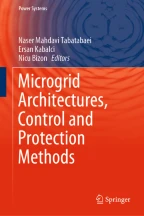Abstract
Due to a number of financial and operational difficulties that have lately been faced by power plants, the electricity industry is exploring a concept as the smart grid to address the problems in the future. There will be significant differences in the conventional power system in the transmission into a smart network, such that when the demand increases, the system does not necessarily generate more electricity to meet consumption needs. In other words, power generation will not be directly dependent on consumption; instead, it will function through reducing losses, managing user demand and cooperating with consumers in order to optimize the load. All of the proposed approaches ensure that the balance between generation and consumption is increased without creating inevitable generation. The smart grid is capable of improving the operation of its components via reducing power costs, reducing additional charges, ensuring maintenance and saving costs of electricity generation, meeting demand and helping to protect the environment. Smart grid energy systems have been developing constantly in order to be able to integrate renewable energy resources, energy storage systems, diesel generators, loads, control systems, etc., which are called microgrids or hybrid power systems, where energy management and planning are of critical importance. There are several functions that are to be considered when dealing with the planning of microgrids, such as load forecasting, the uncertainty of renewable sources, reduction of CO2 emissions, etc.
The original version of this chapter was revised: Abstract has been updated. The correction to this chapter can be found at https://doi.org/10.1007/978-3-030-23723-3_32
Access this chapter
Tax calculation will be finalised at checkout
Purchases are for personal use only
Similar content being viewed by others
Change history
13 September 2019
The original version of this book was published with an older version of the abstract in Chapter 2. This has now been corrected and updated.
References
H. Farhangi, Smart Microgrids—Lessons from Campus Microgrid Design and Implementation (CRC Press, New York, 2017)
H. Bevrani, B. Francois, T. Ise, Microgrid Dynamics and Control (Wiley, USA, 2017)
M. Lydia, S.S. Kumar, A.I. Selvakumar, G.E. Prem Kumar, A comprehensive review on wind turbine power curve modeling techniques. Renew. Sustain. Energy Rev. 30, 452–460 (2014)
A. Kaabeche, M. Belhamel, R. Ibtiouen, Sizing optimization of grid-independent hybrid photovoltaic/wind power generation system. Energy 36, 1214–1222 (2011)
G. Tina, S. Gagliano, S. Raiti, Hybrid solar/wind power system probabilistic modelling for long term performance assessment. Solar Energy 80, 578–588 (2006)
R. Belfkira, L. Zhang, G. Barakat, Optimal sizing study of hybrid wind-PV-diesel power generation unit. Solar Energy 85, 100–110 (2011)
A. Abdollahi, M.P. Moghaddam, Investigation of economic and environmental-driven demand response measures incorporating UC. IEEE Trans. Smart Grid 3, 12–25 (2012)
O. Grothe, J. Schnieders, Spatial dependence in wind and optimal wind power allocation—a copula based analysis. Energy Policy 39, 4742–4754 (2011)
G. Tina, S. Gagliano, V.A. Doria, Probability analysis of weather data for energy assessment of hybrid solar-wind power system, in 4th IASME/WSEAS International Conference on Energy, Environment, Ecosystems and Sustainable Development (2008), pp. 217–223
M. Jones, Kumaraswamy’s distribution a beta-type distribution with some tractability. Stat. Methodol. 6, 70–81 (2009)
P. Kumaraswamy, A generalized probability density function for double-bounded random processes. J. Hydrol. 46, 79–88 (1980)
E.C. Brechmann, U. Schepsmeier, Modeling dependence with C- and D-vine copulas the R package CDVine. J. Stat. Softw. 52(3) (2013)
A. Sklar, Distribution Functions of N Dimensions and Margins, vol. 8 (Publications of the Institute of Statistics of the University of Paris, 1959), pp. 229–231
R.B. Nelsen, An Introduction to Copulas (Springer, 2006)
A. Seifi, K. Ponnambalam, J. Vlach, A unified approach to statistical design centering of integrated circuits with correlated parameters. IEEE Trans. Circuits Syst. Fundam. Theory Appl. 46, 190–196 (1999)
A.E. Gelfand, A.F.M. Smith, Sampling-based approaches to calculating marginal densities. J. Am. Stat. Assoc. 85, 398–409 (1990)
H. Joe, Multivariate Models and Multivariate Dependence Concepts (Springer-Science and Business Media, B.V., 1997)
S. Demarta, A.J. McNeil, The t Copula and Related Copulas (Department of Mathematics, Federal Institute of Technology, Zurich, 2004)
A. Saif, K.G. Elrab, H.H. Zeineldin, S. Kennedy, J.L. Kirtley, Multi-objective capacity planning of a PV-wind-diesel-battery hybrid power system, in IEEE International Energy Conference (2010)
Z. Li, C. Zang, P. Zeng, H. Yu, H. Li, Two-stage stochastic programming based model predictive control strategy for microgrid energy management under uncertainties, in IEEE—PMAPS (2016)
H. Markowitz, Portfolio selection. J. Financ. 7, 77–91 (1952)
Author information
Authors and Affiliations
Corresponding author
Editor information
Editors and Affiliations
Rights and permissions
Copyright information
© 2020 Springer Nature Switzerland AG
About this chapter
Cite this chapter
Aghbolaghi, A.J., Tabatabaei, N.M., Azad, M.K., Tarantash, M., Boushehri, N.S. (2020). Microgrid Planning and Modeling. In: Mahdavi Tabatabaei, N., Kabalci, E., Bizon, N. (eds) Microgrid Architectures, Control and Protection Methods. Power Systems. Springer, Cham. https://doi.org/10.1007/978-3-030-23723-3_2
Download citation
DOI: https://doi.org/10.1007/978-3-030-23723-3_2
Published:
Publisher Name: Springer, Cham
Print ISBN: 978-3-030-23722-6
Online ISBN: 978-3-030-23723-3
eBook Packages: EnergyEnergy (R0)
